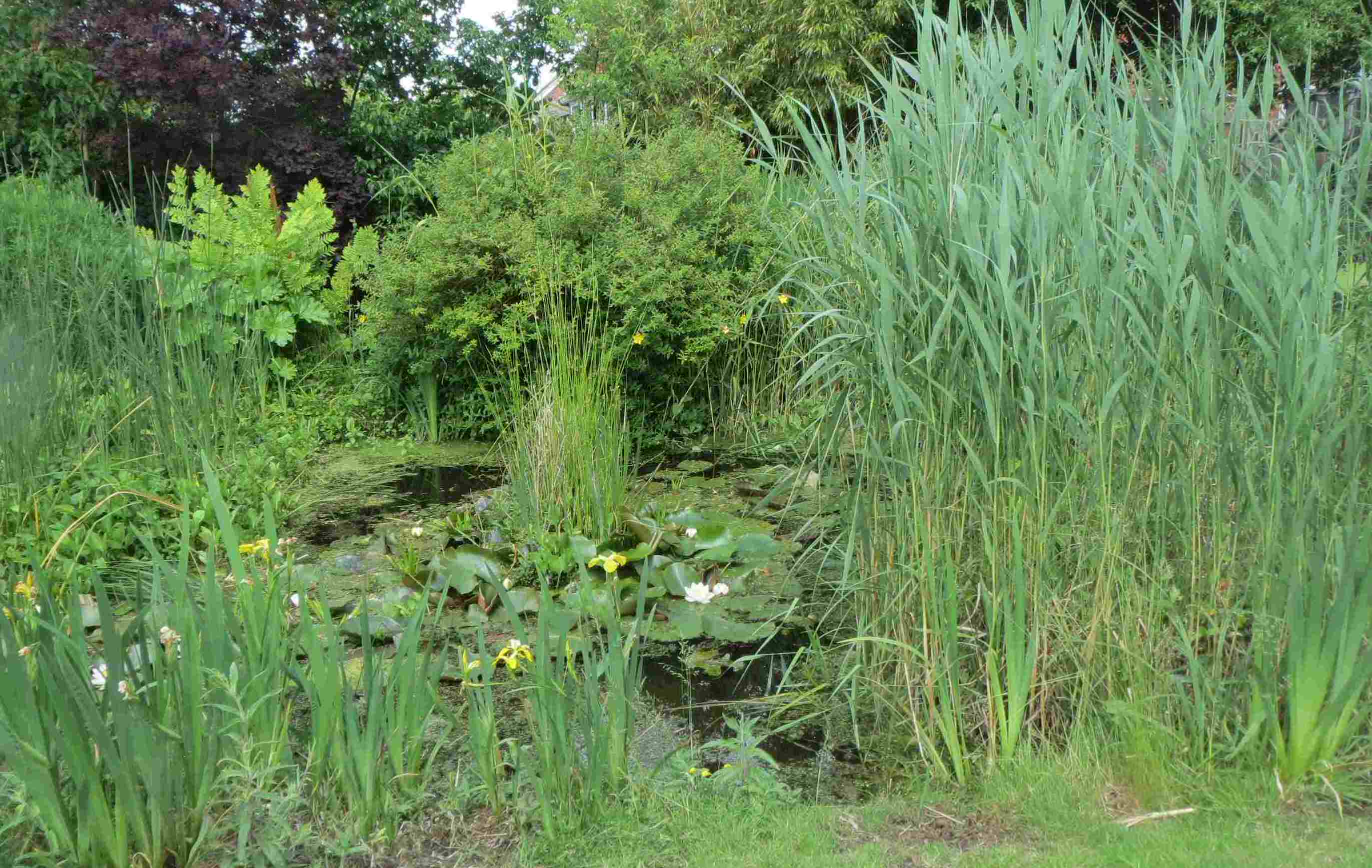

- Home
- Garden Science
- Garden Ecology
- Physical and chemical environment
- Home
- Garden Science
- Garden Ecology
- Physical & chemical environment

The physical and chemical environment of gardens
Gardens exist within their urban or rural landscape, so gardens in Scotland will automatically be rather different from gardens in the Channel Islands because of the difference in climate. But gardens have some special characteristics which make them rather different from the surrounding countryside. We have outlined the main factors below, but download our leaflet The physical and chemical environment of gardens to read more, and learn some of the evidence.
Temperature
Gardens deep in the countryside don’t have any special temperature differences, but gardens in built up areas experience the “heat-island” effect. Hard surfaces like concrete and tarmac, and in particular buildings, heat up in the daytime, and lose their heat slowly at night. The activity of people - transport and businesses, house heating and air
conditioning are also sources of heat. London for example, can be 5°C warmer through the winter than its surroundings, and gets many fewer frosty days. This allows London gardeners to grow tender plants outside, which would otherwise need greenhouses or coastal gardens in Cornwall or the Scillies.
We don’t know yet all the effects this temperature hike has on garden wildlife, but research has shown effects on insects and lawns. Temperature differences will also be found geographically from north to south, and in gardens on hills, where for every 100m altitude increase, average temperatures drop half a degree centigrade.
![By Urban_heat_island.svg: TheNewPhobia derivative work: Alexchris (Urban_heat_island.svg) [Public domain], via Wikimedia Commons](images/Heat island effect.jpg)
The physical and chemical environment
of gardens
Gardens exist within their urban or rural landscape, so gardens in Scotland will automatically be rather different from gardens in the Channel Islands because of the difference in climate. But gardens have some special characteristics which make them rather different from the surrounding countryside. We have outlined the main factors below, but download our leaflet The physical and chemical environment of gardens to read more, and learn some of the evidence.
Temperature
Gardens deep in the countryside don’t have any special temperature differences, but gardens in built up areas experience the “heat-island” effect. Hard surfaces like concrete and tarmac, and in particular buildings, heat up in the daytime, and lose their heat slowly at night. The activity of people - transport and businesses, house heating and air conditioning are also sources of heat. London for example, can be 5°C warmer through the winter than its surroundings, and gets many fewer frosty days. This allows London gardeners to grow tender plants outside, which would otherwise need greenhouses or coastal gardens in Cornwall or the Scillies.
We don’t know yet all the effects this temperature hike has on garden wildlife, but research has shown effects on insects and lawns. Temperature differences will also be found geographically from north to south, and in gardens on hills, where for every 100m altitude increase, average temperatures drop half a degree centigrade.
![By Urban_heat_island.svg: TheNewPhobia derivative work: Alexchris (Urban_heat_island.svg) [Public domain], via Wikimedia Commons](images/Heat island effect.jpg)
Water
Rain generally falls on gardens in the same way as the surrounding countryside, but air rising from big cities can create dry “rain shadows” in downwind suburbs. Where gardens differ is in their owner’s ability to beat drought by watering.
At least half of garden owners water their plants, and this allows them to keep plants healthy (and available to wildlife) during dry spells when they would otherwise wilt or grow very slowly. This must have a beneficial effect on most garden wildlife, as will the many gardens with ponds and bog-gardens, which in very dry spells with hosepipe bans, can be the only really vibrant parts of the garden.
Water
Rain generally falls on gardens in the same way as the surrounding countryside, but air rising from big cities can create dry “rain shadows” in downwind suburbs. Where gardens differ is in their owner’s ability to beat drought by watering.
At least half of garden owners water their plants, and this allows them to keep plants healthy (and available to wildlife) during dry spells when they would otherwise wilt or grow very slowly. This must have a beneficial effect on most garden wildlife, as will the many gardens with ponds and bog-gardens, which in very dry spells with hosepipe bans, can be the only really vibrant parts of the garden.
During the dry summer of 2015, the pond and bog area were the only lush green area left in my garden - so useful for visual attractiveness as well as wildlife
During the dry summer of 2015, the pond and bog garden were the only lush green area left in my garden - so useful for visual attractiveness as well as wildlife.
Disturbance
One strongly negative aspect of most gardens is noise and disturbance from traffic, people and pets. Some of our rarer birds are very intolerant of disturbance, and could never nest in any but the biggest, most deeply rural gardens. Some of our familiar songbirds seem to have adapted to disturbance and tolerate lots of noise, but have been found to have to sing louder, or in higher notes, to make themselves heard and maintain their territories.
Dogs and cats, particularly the latter, are a significant source of disturbance by day and by night. This is one of many areas where gardeners could make useful observations and help our understanding of garden ecology.
Artificial lighting
Another generally negative aspect of urban gardens is their high level of light pollution, such that some urban children may never have seen the stars. Wildlife is definitely affected, with birds singing earlier in the year and later into the evening. Many insects are attracted to light, and some killed by exhaustion, or by bats, which find street lights a benefit by attracting their prey.
Pollution and chemicals
Pollution is nothing like as bad in British cities as it was fifty or more years ago before the Clean Air Act, but we still
suffer from traffic fumes and some industrial air pollution. We know this has significant effects on plants in controlled experiments, but remain ignorant of how much effect it has in garden wildlife in different built up areas.
One other issue here is the tendency of many gardeners to over-fertilise their soils. This isn’t a great problem, but it
can cause poor water quality in garden ponds, and it certainly makes it easy for grass and other weeds to out-compete slower growing and delicate flowering plants.
Leaflets related to this page:
Page written by Steve Head reviewed by Ken Thompson
Disturbance
One strongly negative aspect of most gardens is noise and disturbance from traffic, people and pets. Some of our rarer birds are very intolerant of disturbance, and could never nest in any but the biggest, most deeply rural gardens. Some of our familiar songbirds seem to have adapted to disturbance and tolerate lots of noise, but have been found to have to sing louder, or in higher notes, to make themselves heard and maintain their territories.
Dogs and cats, particularly the latter, are a significant source of disturbance by day and by night. This is one of many areas where gardeners could make useful observations and help our understanding of garden ecology.
Artificial lighting
Another generally negative aspect of urban gardens is their high level of light pollution, such that some urban children may never have seen the stars. Wildlife is definitely affected, with birds singing earlier in the year and later into the evening. Many insects are attracted to light, and some killed by exhaustion, or by bats, which find street lights a benefit by attracting their prey.
Pollution and chemicals
Pollution is nothing like as bad in British cities as it was fifty or more years ago before the Clean Air Act, but we still suffer from traffic fumes and some industrial air pollution. We know this has significant effects on plants in controlled experiments, but remain ignorant of how much effect it has in garden wildlife in different built up areas.
One other issue here is the tendency of many gardeners to over-fertilise their soils. This isn’t a great problem, but it can cause poor water quality in garden ponds, and it certainly makes it easy for grass and other weeds to out-compete slower growing and delicate flowering plants.
Leaflets related to this page: By Steve Head Reviewed by Ken Thompson
Page written by Steve Head Reviewed by Ken Thompson












